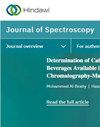Mathematically Processed UV Spectroscopic Method for Quantification of Chlorthalidone and Azelnidipine in Bulk and Formulation: Evaluation of Greenness and Whiteness
IF 2.1
4区 化学
Q4 BIOCHEMICAL RESEARCH METHODS
引用次数: 3
Abstract
A simple, eco-friendly four analytical methods were established by improving the selectivity through the application of mathematical processing of UV absorption spectra for concurrent quantification of chlorthalidone (CTL) and azelnidipine (AZE). The UV absorption spectra were recorded using environment-friendly ethanol (10% v/v) and were mathematically processed using simple software provided with a UV spectrophotometer. The analytes’ peak amplitude was determined using zero-crossing point first derivative spectra and ratio first derivative spectra of CTL and AZE, which were measured at 238.5 nm and 239.5 nm for CTL and 272.1 nm and 342.1 nm for AZE, respectively. The peak amplitude difference was determined from the ratio spectra of CTL and AZE by measuring the peak amplitudes at 211.8 and 267.2 nm for CTL and 328.4 and 286.1 nm for AZE. Further, ratio spectra of CTL and AZE were converted into zero-order spectra by subtracting the constant followed by multiplication with divisor spectra, and the peak amplitudes were measured at 226.9 nm and 257.3 nm for CTL and AZE zero-order spectra, respectively. Further, validation results of all the four methods confirmed the accuracy and precision of the methods by displaying good recovery (98.37–100.34%) and percentage relative standard deviation (0.397–1.758%), respectively. Good linearity was observed in the range of 1–15 μg/mL for both analytes with less than a 1 μg/mL limit of quantification. Further, the greenness and whiteness of the methods were evaluated by recently proposed AGREEness, complexGAPI, and white analytical chemistry techniques. The proposed UV spectroscopic methods were environmentally friendly, safe, economic, and effective, hence, could be used for regular quality control study of a formulation containing CTL and AZE.数学处理紫外光谱法定量测定原料药氯噻酮和阿泽尼地平的绿度和白度
通过对紫外吸收光谱进行数学处理,提高选择性,建立了一种简便、环保的氯噻酮(CTL)和氮唑地平(AZE)同时定量的四种分析方法。用环境友好型乙醇(10% v/v)记录紫外吸收光谱,并使用紫外分光光度计提供的简单软件进行数学处理。利用CTL和AZE的零交叉点一阶导数光谱和比值一阶导数光谱测定分析物的峰幅,CTL和AZE分别在238.5 nm和239.5 nm处测定,AZE分别在272.1 nm和342.1 nm处测定。通过测定CTL和AZE在211.8和267.2 nm处的峰幅值,以及AZE在328.4和286.1 nm处的峰幅值,确定了CTL和AZE的峰幅值差异。将CTL和AZE的比值光谱减去常数,再与因子光谱相乘,转换为零阶光谱,分别在226.9 nm和257.3 nm处测得CTL和AZE的零阶光谱峰幅。4种方法的验证结果均显示出良好的回收率(98.37 ~ 100.34%)和相对标准偏差(0.397 ~ 1.758%),证实了方法的准确性和精密度。两种分析物在1 ~ 15 μg/mL范围内线性良好,定量限小于1 μg/mL。此外,通过最近提出的AGREEness、络合gapi和白色分析化学技术对方法的绿度和白度进行了评价。该方法环保、安全、经济、有效,可用于含CTL和AZE制剂的常规质量控制研究。
本文章由计算机程序翻译,如有差异,请以英文原文为准。
求助全文
约1分钟内获得全文
求助全文
来源期刊

Journal of Spectroscopy
BIOCHEMICAL RESEARCH METHODS-SPECTROSCOPY
CiteScore
3.00
自引率
0.00%
发文量
37
审稿时长
15 weeks
期刊介绍:
Journal of Spectroscopy (formerly titled Spectroscopy: An International Journal) is a peer-reviewed, open access journal that publishes original research articles as well as review articles in all areas of spectroscopy.
 求助内容:
求助内容: 应助结果提醒方式:
应助结果提醒方式:


